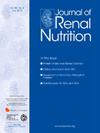Nutritional Status of Patients Starting on Peritoneal Dialysis: A Comparison Between Planned and Unplanned Dialysis Initiation
IF 3.2
3区 医学
Q2 NUTRITION & DIETETICS
引用次数: 0
Abstract
Objective
A suboptimal dialysis initiation with insufficient or no planning before urgent start of dialysis remains a common problem associated with increased morbimortality. Whether nutritional markers differ between patients starting peritoneal dialysis (PD) in unplanned and planned modes has not yet been explored. Therefore, we aimed to evaluate whether the nutritional status at the start of dialysis differed between patients with unplanned and planned PD initiation.
Methods
In this observational study comprising 47 adult patients starting PD (age 58 ± 15 years, 51% female), 29 patients had unplanned (starting dialysis up to 72 hours after peritoneal catheter implantation) and 18 planned (follow-up predialysis >90 days) dialysis initiation. Within 30 days of PD initiation, nutritional status was evaluated using anthropometric measurements, multifrequency bioelectrical impedance analysis, appetite assessment, handgrip strength, laboratory markers, and the malnutrition-inflammation score. Physical activity and performance were also evaluated.
Results
Patients with an unplanned PD initiation had a higher frequency of diabetes, higher blood glucose, urea, and glycated hemoglobin levels, and lower hemoglobin and albumin levels. Furthermore, they had a lower calf circumference, slower gait speed, higher protein intake, and greater malnutrition-inflammation score, while their physical activity level and appetite did not differ.
Conclusion
Patients with an unplanned PD had unfavorable clinical and nutritional markers compared with those with planned PD. These findings indicate that a lack of follow-up prior to dialysis initiation can influence the clinical and nutritional statuses of patients, reinforcing the importance of conservative treatment prior to dialysis initiation.
开始腹膜透析患者的营养状况:计划内透析与计划外透析的比较。
背景:在紧急开始透析之前,透析启动不够理想或没有计划,这仍然是一个与死亡率增加有关的常见问题。尚未研究过以非计划方式和计划方式开始腹膜透析(PD)的患者之间的营养指标是否存在差异。因此,我们旨在评估非计划性腹膜透析和计划性腹膜透析患者开始透析时的营养状况是否存在差异:在这项由 47 名开始透析的成年患者(年龄为 58±15 岁,51% 为女性)组成的观察性研究中,29 名患者为非计划性透析(腹膜导管植入后 72 小时内开始透析),18 名患者为计划性透析(透析前随访时间大于 90 天)。在开始透析的 30 天内,使用人体测量、多频生物电阻抗分析、食欲评估、手握强度、实验室指标和营养不良-炎症评分(MIS)对营养状况进行了评估。此外,还对体力活动和表现进行了评估:结果:计划外开始腹膜透析的患者患糖尿病的频率较高,血糖、尿素和糖化血红蛋白水平较高,血红蛋白和白蛋白水平较低。此外,他们的小腿围较低,步速较慢,蛋白质摄入量较高,MIS较大,而体力活动水平和食欲没有差异:结论:与计划进行腹膜透析的患者相比,未计划进行腹膜透析的患者的临床和营养指标较差。这些研究结果表明,开始透析前缺乏随访可能会影响患者的临床和营养状况,从而加强了开始透析前保守治疗的重要性。
本文章由计算机程序翻译,如有差异,请以英文原文为准。
求助全文
约1分钟内获得全文
求助全文
来源期刊

Journal of Renal Nutrition
医学-泌尿学与肾脏学
CiteScore
5.70
自引率
12.50%
发文量
146
审稿时长
6.7 weeks
期刊介绍:
The Journal of Renal Nutrition is devoted exclusively to renal nutrition science and renal dietetics. Its content is appropriate for nutritionists, physicians and researchers working in nephrology. Each issue contains a state-of-the-art review, original research, articles on the clinical management and education of patients, a current literature review, and nutritional analysis of food products that have clinical relevance.
 求助内容:
求助内容: 应助结果提醒方式:
应助结果提醒方式:


